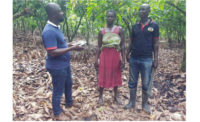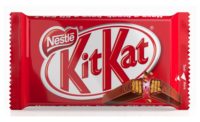Kraft Embraces Cocoa Sustainability Via Rainforest Alliance Certification
About 4,000 Cote d’Ivoire cocoa farmers stand to benefit thanks to an ambitious new project from the Rainforest Alliance environmental group, Kraft Foods and the U.S. Agency for International Development.
The project involves educating farmers in
eco-friendly, sustainable agricultural practices that will allow them to
increase cocoa yields while better protecting the environment.
Participating farmers will work toward achieving Rainforest Alliance
certification by meeting a series of environmental and social standards
that include conserving natural resources, protecting the welfare of
workers and putting more efficient management practices into place.
The first deliveries of Rainforest Alliance Certified
cocoa from the C’ote d’Ivoire –- which Kraft is slated to
purchase –- are expected in 2007. Farmers who produce this
sustainably grown certified cocoa can expect to increase profits by from 15
to 20 percent initially, says Frank Hicks, a Rainforest Alliance program
director, who has been working in West Africa to help get the certification
venture there established.
Other partners in the project include the German
Agency for Technical Cooperation and a cocoa trader in Cote d’Ivoire
called the Armajaro Group. The partners in the project coalition are
investing nearly $2 million to benefit cocoa farmers in six cooperatives
over a three-year time span.
The project — while formidably difficult —
is progressing well, says Jonathan Atwood, director of commodity
sustainability programs at Kraft. “I don’t think we could be
happier about how it is setting up,” he notes.
Patience and realistic expectations are key for
participants in such ventures, says Atwood, who notes that, “It will
take some time in 2007 to get some volume [of certified cocoa].”
The Cote d’Ivoire project is modeled on a
successful Rainforest Alliance program initiated in Ecuador in 1997.
“I think the challenges in terms of literacy and education [for the
participating farmers] are even greater in the Ivory Coast,” says
Hicks. For example, he points out that people there don’t all speak
the same local language, whereas in Ecuador almost everyone speaks Spanish.
Atwood agrees that the venture presents plenty of
challenges. “We didn’t go into this expecting that it will be
easy,” Atwood continues. “Farming in West Africa is difficult
for a number of reasons — poverty, childhood mortality, [deficiencies
in] educational structure, less efficient agricultural
practices.”
Fortunately, Kraft has experience as a participant in
the Ecuador cocoa project. The company also has a sustainability program
model outside the cocoa category. Kraft’s partnership with the
Rainforest Alliance started in 2003 on a coffee certification program.
“We’re the largest buyer of Rainforest
Alliance Certified coffee,” says Atwood. By the end of 2006, the
company will have purchased 26 million pounds of it.
A number of Kraft’s European brands are
Rainforest Alliance certified. In the United States, the company’s
Rainforest Alliance certified brand is Yuban, which carries the tag line,
“The coffee you make can make a difference.”
“Our tag line says it all,” Atwood says.
Products made with cocoa grown on Rainforest Alliance
certified farms will be eligible to feature the Rainforest Alliance seal on
their label.
Atwood is enthusiastic about the fact that a food
company of Kraft’s size has allied itself so strongly with
sustainability. Thus far, he points out, many of the brands that have
forged a strong connection to social or environmental causes have come from
niche players.
“What we’re trying to do is to bring the
idea of sustainability to mainstream brands,” he says. “So
it’s a bit of a different challenge, but it’s one that we think
is worth undertaking.” n
Consciousness Raising in the Grocery Aisle
How much do consumers care about purchasing products
that are flagged as eco-friendly or sustainably grown?
Lynn Dornblaser, director of Custom Solutions at
global research firm Mintel International, is convinced that interest is
mounting.
“The causes that they champion differ a
little,” says Dornblaser. “But the point is that more and more
companies are engaging in sustainability issues or engaging in corporate
and social responsibility.”
Buying an eco-friendly or fair trade product allows
for “passive participation” in a worthy cause, Dornblaser
reflects. “It helps consumers feel good and sends a message to those
around them that they are aware.”
European shoppers tend to be more attuned to such
issues, notes Dornblaser. “With European consumers, because of
heritage and geography and history, it seems that they have a better
understanding of where food comes from and what goes into raising animals
or crops,” she observes.
However, U.S. consumers are becoming better informed
in this arena. With more international travel, our world view is expanding,
and with it our collective social consciousness, she continues.
“More people are learning foreign languages;
more people are getting passports,” says Dornblaser. “And I
think a lot of that is driven by today’s younger consumers, the
millenials, who are in their 20s. I think they’re more aware of the
wider world. And that ties really well into the whole idea of being more
socially responsible.”
Jonathan Atwood, director of commodity sustainability
programs at Kraft Foods, agrees with Dornblaser that Europeans may be bit
more forward-thinking in this area, but he is convinced that the interest
exists on the domestic front as well.
“The common thread that I hear is that
people do care about what their products are made of and that they
understand something about where they came from,” says Atwood.
“And that [they care that] people who grew the ingredients are
treated fairly.”
As for the marketing of such products, the more simply
the message is presented, the better the odds are that it will be heard,
says Dornblaser. She cites the example of the endangered animal photos
featured on bars of Endangered Species Chocolate.
“To me, that’s really smart,” says
Dornblaser, “because it sends the message really clearly that if you
buy this, you’re helping a tiger. Consumers need messages that are
really easy to communicate.”
Pricing, of course, can be a stumbling block. The
bottom line is, a marketer can’t charge too much more for a product
with a socially responsible back-story or mainstream consumers won’t
go for it.
“If it costs more, there will be only a small
core of dedicated consumers who will pay the price premium,” says
Dornblaser.
“I think for these kinds of products to really be
successful long-term, they’ve got to find a way for pricing to be as
close as possible to other products,” she continues.
“Consumers are more price conscious than they are
environmentally conscious.”


